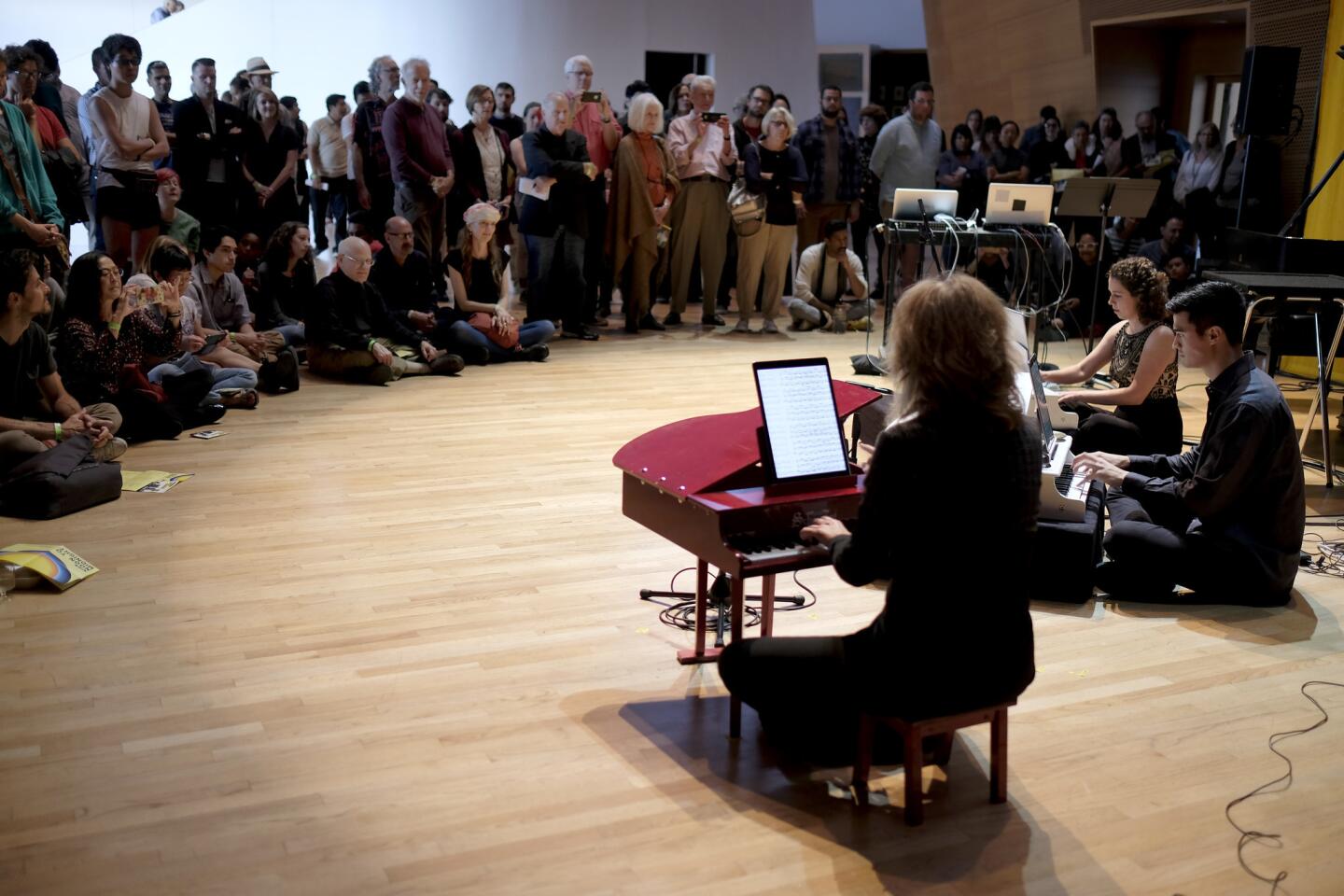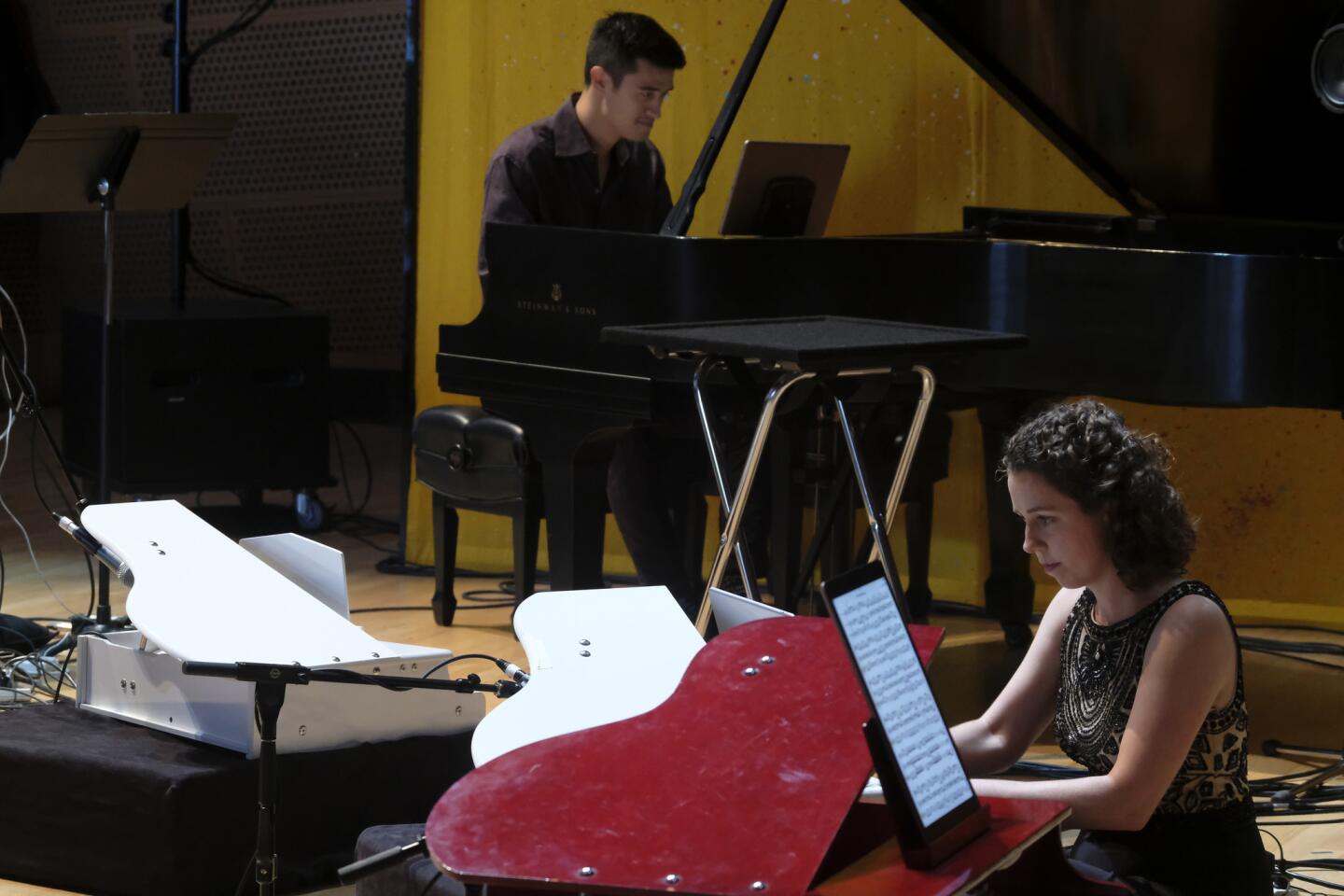Review: Noon to Midnight, L.A. Phil delivers new music (and free ice cream)
- Share via
The logo for the Los Angeles Philharmonic’s 12-hour new music extravaganza, Noon to Midnight, was a large bright yellow sun surrounded by a color wheel of small rings darkening from orange to, well, midnight blue. So it was Saturday at Walt Disney Concert Hall.
I began by skirting the morning’s long, long box office line for $10 tickets that got you into everything except the two repeat performances of Annie Gosfield’s “War of the Worlds” and headed over to the Tinker Toy parking lot across the street. It was one of three outdoor sites for ancillary performances of Gosfield’s opera, the conception of “War of the Worlds” librettist, director and Svengali, Yuval Sharon. If you could survive the relentless sun beating down, you had no need to panic over a menacing heat ray from invading aliens.
A dozen hours later I chilled in Disney’s fancy Founders Room, turned over for once to the hoi polloi and taken over for intriguing sound and video installations, along with live performances of alluring drone works by the wulf. That’s the name of a different sort of founder, an artists’ loft (being forced out by rising rent) in a once dodgy part of downtown that helped create the DTLA new music scene that Noon to Midnight celebrates. We lounged on the pillows and chairs and drank free wine as though we were big shots at L.A. Phil intermission.
This was the second of what promises to be an annual marathon of pop-up performances inside and all around Disney Hall. No cranny was safe from new music. Eighteen SoCal ensembles, most made up of the least daunted young performers you are likely to encounter anywhere, held court. More than 50 pieces were played, with the main focus on our decade. Twenty were world premieres; six, L.A. Phil commissions. As many as four events were allowed to go on at the same time.
The garden was turned into a beer garden. Food trucks took over the sidewalk in front of the hall. Disney and its environs were packed with young people, art-world sophisticates and old timers. Out-of-towners attracted by “War of the Worlds” couldn’t quite believe what they were seeing — a concert hall living up to architect Frank Gehry’s intention of being the living room for the city and gutsy young composers and performers (one and the same in many instances) the toast of the town. I wish Mayor Eric Garcetti, who made a delightful surprise appearance in the first performance of “War of the Worlds” a week earlier, had returned to reprise his role rather than send an email for narrator Sigourney Weaver to read. City officials need to witness this first hand.
But what do you actually witness? It’s as much a party as a gaggle of performances. You’re handed a sheet that lists places, performers and pieces, but no additional information is offered. The music must speak for itself.
The typical way to take in the day is to graze. Duck into this program in the hall; catch those percussionists creating pure magic in the garden as the sun sets. A beer break. A ridiculously gloppy food-truck sandwich for dinner that is easy to regret. A free scoop courtesy of the great Peddler’s Creamery that is no problem working off. My phone informs me that I walked three miles and climbed 28 floors during the marathon.
Stick it out to the bitter end and if the sun doesn’t fry your brain at noon, the onslaught of new work will do the trick. It’s all a jumble, so please don’t expect a rundown of pieces and performances.
The biggest overall impression was the level of experimentation, particularly with the groups that are part of the DTLA scene. There is a sense around the country that new music has been co-opted by marketing forces, be it the need to mollify conventional symphony and opera audiences or the increasingly cozy relationship between young composers and the commercial pop world. There was, as far as I could tell Saturday, none of that.
Young people — and a handful of older people too — made strange sounds because timbre and tone matter. A lot of music was abstract yet absorbing. New ideas were tried out. A lot of them worked.
Christopher Rountree was the most notable presence of the day, conducting the two performances of “War of the Worlds” and two full programs with his own new music ensemble, wild Up. One of those was devoted to the premieres of six new works by composers between the ages of 18 and 30 who are invited to participate in the L.A. Phil’s National Composers Intensive.
This year, three of the composers were from the U.S. and three from Mexico. They gathered during the orchestra’s CDMX festival of Mexican music last month to workshop their pieces. Each has something marvelous to offer — spacey harmonics, ominously growling brass, thumps and squeaks that could make you smile, soothing sounds of tearing paper (something we all have too much of in our lives), the satisfying pops of bubble wrap, pulses that come and go or that never come because you don’t need them, the always alluring plunks of a prepared piano. The composers are David Bird, Tonia Ko, Aldo Lombera, Nate May, Erika Vega and Juan Andrés Vergara.
Wild Up itself has grown from its origins as a group of feisty students and recent grads to a first-rate ensemble with a distinctive L.A. personality. Rountree now sports a suit, and players’ dress is new-music black, not whatever is clean in their closets. Their concertmaster, Andrew Tholl, is quickly becoming a significant composer, and the premiere of his new work, “every moment is an opportunity to shine,” for 13 solo strings seated in a semi-circle, began like Arvo Pärt and then got harmonically strange and into a crazy pizzicato frenzy that was an opportunity to sparkle.
What else? Los Angeles Electric 8 (eight electric guitars) played Daniel Corral’s “Circle Limit III” on the sidewalk in front of Disney producing a stunning wall of sound as aural complement to Gehry’s steel. Steve Schick and his UCSD percussion ensemble, red fish blue fish, kept the garden and outdoor amphitheater buzzing and beating much of the afternoon with big, arresting pieces by John Luther Adams, Gérard Grisey and Wenjing Guo. SASSAS’ noise jam made an ungodly racket.
A snappy new chamber symphony premiered by Jacaranda proved playful and inventive, its twists and turns a pleasure. The chamber orchestra, Kaleidoscope, bopped along to a recording of robotic voices in the premiere of Pamela Z’s “And the Movement of the Tongue.”
The imaginative Southland Ensemble added very good vibes to Chris Kallmyer’s installation, “Soft Structures,” that modeled a stage in BP Hall after a Case Study house with “very good vibes.” Monday Evening Concerts took over that space late in the evening with more good vibes — Michael Pisaro’s utterly satisfying sound of rice dropping and an inviting new solo harp piece by Anne LeBaron, “Poem for Doreen.” The four-member gnarwhallaby was as impressively gnarly as its name in a difficult, complex new piece by Richard Barrett.
There was more, much more that I missed, including the cello-piano duo Photinos & Ray, the USC Percussion Group, Rage Thormbones and Hocket. So I’ll stop with the T-shirt. On its all-encompassing road to becoming the Apple of orchestras, the L.A. Phil has even gotten into good design: It makes, as with CDMX and now Noon to Midnight, the best orchestra T-shirts in the business.
MORE MUSIC:
When refusing the hour saves the day
Bernstein’s spirit brought back to the stage
Ojai Music Festival’s artistic director to retire
‘War of the Worlds’: Delirious opera rises from the destruction of L.A.
More to Read
The biggest entertainment stories
Get our big stories about Hollywood, film, television, music, arts, culture and more right in your inbox as soon as they publish.
You may occasionally receive promotional content from the Los Angeles Times.
















